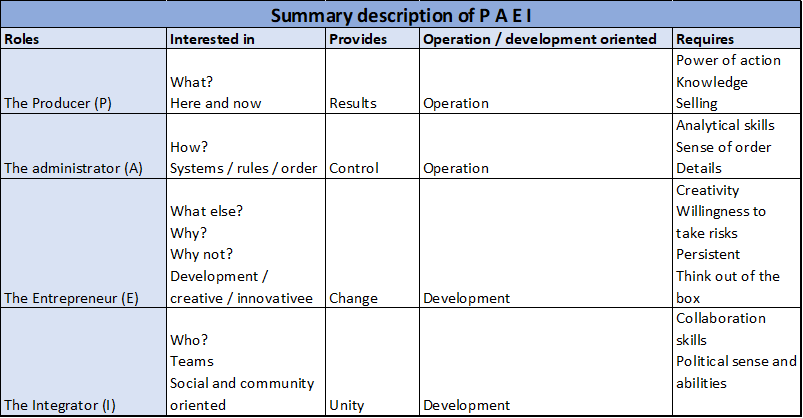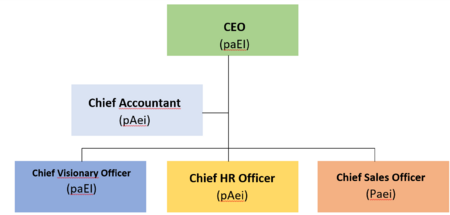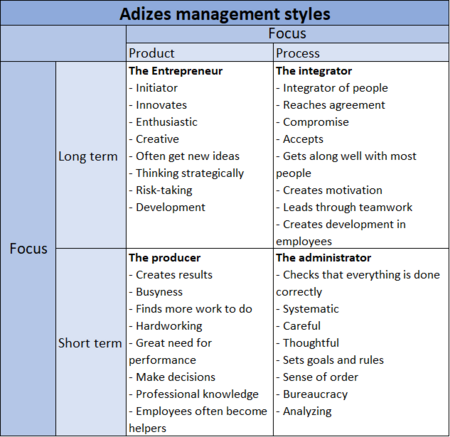Adizes management styles
Contents |
Abstract
This article aims to deepen Ichak Adizes' Management Styles theory and put it in relation to how it can be used by project managers and individuals. Adizes believes that are four management styles in which has its own "PAEI"-profile and that the perfect team includes all four management styles. Each profile has its own strength which is unique to this particular type of profile. Typically, the profiles will be each others opposites which can cause difficulties in the team. There must be balance in a team, which is why all four roles must be represented by one/two or more people [1]. A person will often possess competencies within several styles, but may not hold all four management styles at one and the same time. As a person sees himself as consisting of all four styles and manage them, there is typically some form of mismanagement. Mismanagement can occur in several ways, of which the above is one of these. Furthermore, mismanagement can occur when one or more managers consist exclusively of one of the four styles, and which Adizes describes as the extreme of mismanagement. However, this is often seen only rarely, but will lead to major conflicts in the team.
Adizes describes that the perfect team is not entirely without problems, but if all four styles are present, the perfect balance is achieved. [2]. Adizes believes that it requires a certain understanding of the styles you don't possess yourself to be able to work with managers with other strengths and that's the only way a good management team is formed.
Ichak Kalderon Adizes
Ichak Kalderon Adizes is a North Macedonian business consultant, professor and known as one of the world's leading experts in management and business development. He was born in Macedonia and later moved to Israel, where he grew up. Ichak Adizes works with management, mismanagement, leaders and teams. In his theory, he works with four management styles, which are very different from each other, but which are all necessary in a fundamental management team [3] According to Adizes, it is not possible to combine all roles in one and same person, as the roles are incompatible. Adizes therefore states that leadership should take place in teams where the team can complement each other and support each other in the weak elements [4].
Management
To create a successful organization, business or management of a project, it requires a leader and or a management team. This team must manage and guide the organization towards achieving a specific result and or product, also called Management [5]. Management is often characterized by, quote, “Management is doing things right” [6]. In addition, management must also be described as a social process involving the interaction between people who must work together to make the organization more efficient [7]. According to ISO standard 21502 [8] and several bibliographic sources , [6], [9] , management activities are systematic, proactive and include:
- Planning
- Coordination
- Proactive in adapting to environmental change
- Motivation of the team
- Supervision
- Create efficient processes
- Managing risks
- Adhere to budgets
Management styles according to Adizes
Adizes defines management as a meaningful process, as management is focused on achieving a specific and targeted result. Management is described as a systematic and proactive process, where decisions are made for specific reasons, in a specific order with a focus on timing and methodology . Unlike leadership, management is a process based on expectations of what will happen in the future and thus proactively adapt to the changes and events of the environment [6]. Furthermore, Adizes describes management as a social process where people work in teams to create an effective organization [4].
Adizes describes four different styles with different characteristics in his management style theory that are indispensable in a team. These are the producer, the administrator, the entrepreneur and the integrator. All four styles must be present and are, according to Adizes, necessary prerequisites for a well-functioning team and skilled management. If any of the above styles isn’t represented, there will be a tendency to mismanagement. A manager must to a greater or lesser extent be able to act based on all four functions, but according to Adizes, no manager can be expert in all four styles and therefore cannot hold all four styles to the same extent. Adizes describes that several managers must be able to cover all four styles together to complement each other's strengths and weaknesses to create the perfect leadership team. In other words, complementary teams are best. For that reason, it is inevitable to face conflicts and one must be willing to accept different styles and opinions in the team. The four management styles are all necessary to develop an organization in the right direction in the long term and to streamline the organization in the short term it’s important to produce, manage, implement and integrate [10].
The Producer (P)

The producer style, also denoted by the management profile Paei (Capital letter P, the rest in lower case) has a great need for performance and typically has difficulty putting the work aside in everyday life. The producer is committed but can often have difficulty delegating the work and prefers to do things himself [12]. The Producer style is about getting thoughts translated into action, with a focus on achieving the set goals. The producer is results-oriented and requires action to get the work done here and now. Typically, the producer has a broad technical knowledge and is interested in the specific work tasks. Managers who possess great producer style qualities do not have much patience due to their great focus on action and results, which makes things go fast. They thrive best in a dynamic environment and do have a great drive to get things done. The manufacturer tends to expect the same characteristics from its employees. If the employees don’t live up to the manufacturer's expectations, the manufacturer typically performs the tasks himself. The producer style is in many contexts associated with a workaholic, as he or she often finds it difficult to put work aside.
Therefore, the style of the producer requires action to get the work done in proper time as well as great professional knowledge within the services that the organization works with [10].
The Administrator (A)

The administrator, also denoted by the management profile pAei (Capital letter A, the rest in lower case) is characterized by going very much into processes, methods and preoccupied with complying with laws and regulations. The administrator often has difficulty making decisions, compared to the producer. The style of the administrator is, as the word implies, happy to keep order and put things in systems and is also practical and rule-oriented. This type of manager possesses great analytical skills, is very thoughtful and has a highly rational mindset [4]. Compared to the producer, the administrator's focus is on the process (directed at “how”), while the producer's focus is on the task (directed at “what”). In other words, the administrator is a man or woman of order and at least as important a part of the management team as the producer [14].
The Entrepreneur (E)

The entrepreneur, also denoted by the management profile paEi (Capital letter E, the rest in lower case) is curious and continuously challenges the company by asking critical questions about the company's approach and the efficiency and effectiveness of tasks [4]. An entrepreneur is innovative and has characteristics that are most often associated with a developer. The entrepreneur is creative, inventive and is often characterized by selling ideas to the people he associates within the organization and management team. The entrepreneur can often tend to question whether the tasks are performed in the right way and whether it is the right tasks that are performed and as a result of that, characterized as thoughtful. On the other hand, the producer style will immediately start solving the given tasks with the method that has been made available, while the administrator will adhere to the established framework and begin to systematize the working methods [16].
The integrator (I)

The integrator, also denoted by the management profile paeI (Capital letter I, the rest in lower case) is practical and very social-oriented. This management style cares deeply about the relationship between the people in the company and the creation of a good and common organizational culture. Likewise, the integrator possesses a great amount of social intelligence. The integrator is good at listening and typically handles the emotional management tasks, by caring for all employees in the organization [4]. The integrator is characterized by the fact that he or she has a strong focus on resolving conflicts and works towards a good community among employees, with space for everyone. The integrator sees opportunities for collaboration and always knows who and which stakeholders needed to be involved in a specific case. However, the integrator often tends to over-analyze underlying intentions to avoid conflicts and reconcile team members.
This manager's weakness is that he or she tends to avoid conflicts of any kind and therefore often change his opinion if there is any opposition to these opinions and decisions [18].

Example of a management team
A number of companies have profile analyzes carried out by future as well as new managers, with the aim of creating complementary management teams. As described earlier, a good management team according to Adizes, consists of several managers who together cover all four styles at a high level. A management team can be structured in many ways, but a classic example is shown in the figure below, which is a generalized picture of an optimal management team.

The figure also shows that there are several considerations that must be taken and fulfilled when hiring a new leader or manager in a team. Among other things, you must be aware of what the team is missing and hire the right profile in the right position. This means that the Administrator should hardly be employed as development manager and the producer should not be employed as HR manager.
PAEI-Profile - The coding system

Any manager will consist of some sort of hybrid of these four styles and manage all four styles to some extent. To avoid mismanagement, it is necessary that a manager isn’t blank in one or several styles. Every manager has the opportunity to test themselves and thus find their personal management Profile. A profile will reflect your management profile and one or more roles will stand out strongly in the profile by a capital letter. If your profile stands out strongly on two or more roles at the expense of the other roles, this will be an indication that the prominent roles appear in an integrated whole. The test is thus a possible way to prove any manager's manager profile. The profile will then typically consist of one to two capital letters, which is an expression of your specific competencies within Adize's manager styles.
Adizes has created the following coding system [4].
- Capital letter: P, A, E, I mean that the manager fits the characteristics of the styles in question. If the manager's profile consists of “Paei”, this manager will possess the producer style characteristics in particular.
- Lowercase letters: p, a, e, i mean that the manager to a somewhat lesser extent possesses the style. If the manager's profile consists of “Paei”, this manager will, to a certain but lesser extent, hold the styles of entrepreneur, administrator, integrator, but still mainly possess the characteristics of the producer.
- A Zero in a certain style means that the manager doesn’t perform this role to any extent. If the manager has a profile consisting of P0EI, this manager does not hold the administrative role and in other words, mismanagement will occur [10].
According to Adize's theory, it is possible to place the four styles in a figure that illustrates the style in relation to the product vs the process and the time horizon in short and long term, respectively.
The producer and the entrepreneur are interested in the organization's products and results in the short and long term, respectively, while the administrator and the integrator are interested in the formal and social system and procedures.
For example, the producer style is significantly product-oriented, while the integrator has its primary focus on the process.
Likewise, the manufacturer is seen to have its focus in relation to the time horizon in the short term, meaning things must happen now and here, while the contractor has its focus in the long term [10].
Application
Adizes 'management styles are relevant to a project manager as the theory is about constructing the optimal team based on the respective team members' personal PAEI profile [4]. One of the project manager's core tasks is to create a collaborative team and project environment, all of which work effectively towards a common goal. Adizes management styles can be used by a project manager to put together an optimal team that complements each other [19]. This mean team members who complement each other with overlapping skills. A project manager can therefore use Adizes' PAEI-theory to form an overview of the team members' skills, strengths and weaknesses. Based on this, the project manager can put together a team where the members each have strengths within either, the P, the A, the E and the I, which according to Adizes’ management styles theory gives the most optimal outcome [20]. All management styles are important and useful in management of any type of organization. Every manager should be a combination of all four management styles and thus not only be dominated by one of the styles. However, it is essential that a manager must not be completely in addition to knowledge within one of the roles and thus be blank (0) in one of the functions [10]. In practice this means that companies, organizations or the individual can conduct a profile analysis based on Adizes management theory. Thus, the company can gain insight into the future manager's strengths and/or weaknesses, which can be crucial in assessing whether the manager will complement the management team he or she should be part of. Thus, the theory can help create awareness in connection with optimizing a management team. This is done, for example, by analyzing what / which function the team lacks, but also being aware that the position to be filled fits the right profile. For example, the contractor should not be employed as an accounting manager [10] The theory can also be applied at the individual level, in which the theory, among other things, can be included as part of manager development, where the manager must get to know himself, his qualities/weaknesses and accept them. According to Adizes theory, the good manger, by virtue of the awareness of his own profile, will be able to identify skills in others where he is weak as well as accept others who have a profile that differs from his own [21]. Becoming aware of your own PAEI profile can help avoid mismanagement.
Mismanagement
Mismanagement can occur in several ways and occurs most frequently when a manager tends to believe he or she masters all four management styles. The person sees himself as the manager who can cover all roles and therefore possesses the profile PAEI. Adizes describes this as the "textbook leader" and simply impossible to achieve. According to Adizes, this profile does not exist, but is self-deception that makes us adapt to the situation. Mismanagement occurs when there’s an absence of one or several styles. As Adizes describes it, we are strong in one or some styles, but not all of them. This scenario is familiar to most people from everyday managers, where distinctiveness and one-sidedness recur [4]. To avoid mismanagement, it is important to understand the styles and qualities that one does not master and possess. Only in this way is it possible to understand and respect the people you work with and in that way form the perfect management team, which together can ensure that all four styles are performed adequately [22]. Adizes also lists the extremes of mismanagement. Adizes describes these extremes of mismanagements as the managers who only handle one of the four roles in their "PAEI profile".
The Lone Ranger (P---)
The manager who exclusively holds the P-role is enormously productive and hard-working. He is typically the first to show up for work and often has many tasks to take care of. However, this manager is not good at planning, delegating or coordinating work tasks (missing A). The manager is not interested in interacting with others, collaborating, nor has any interest in developing his employees (missing I). In addition, the manager is not creative either and focuses exclusively on the task rather than coming up with new creative possibilities or ideas for the process (missing E) [4].
The Bureaucrat (-A--)
This manager has control over the tasks he performs. He only follows the rules and checks that everyone else does the same. The manager works systematically and often slowly, to ensure that no details are missing. Decisions are made solely based on whether they comply with applicable laws and regulations and nothing else. This manager always shows up on time and typically has an agenda for the day. For company meetings, this manager is the person who argues that things cannot be done and what needs to be paid attention to in order not to violate any rules or paragraphs. Other employees will think that this manager never produces anything (missing P). He never comes up with new innovative ideas (missing E) and does not think about the organization's community and teamwork (missing I) [23].
The Arsonist (--E-)
The arsonist always has new dreams and ideas that often affect everyday routines and scheduled meetings and tasks. This manager requires renewal and may tend to spontaneously reverse the priorities if a new idea arises. This manager often seems fickle and employees often have a hard time knowing how aware he is of new and previously delegated tasks. The arsonist can have very varied working days. Some days he may go home early, while other days he may be late at night when he is busy with a task. This manager has no agenda and sitting still bores him. For meetings, he is the manager who talks the most. Adizes describes that in a short period of time it can be hugely exciting to work with such a manager. You’ll learn something and there is always something to take care of. However, this manager will quickly lose interest in the details and execution of the task, which affects the employees' motivation and desire to work [24].
The Super Fellower (---I)
A person who does not hold any of the aforementioned roles is called a super follower. The meaning lies in the word and describes a person who always follows others and as far as possible tries to satisfy the needs and attitudes of others. For the meetings, this manager is often the one who listens actively and rarely makes any decisions. For everything in the world, the manager avoids conflicts and tries as far as possible to create peace and tranquility [25].
The Nullar (----)
Another form of mismanagement is the nullar who neither provides P, A, E or I. This is furthermore one of Adizes extremes and is described in several contexts as a manager who has previously held one of the above styles but has been placed in the wrong context with wrong work tasks [26]. It could be the producer or an Arsonist who has been hired as the team's accountant and is tired of standard administration tasks such as bookkeeping or superficial work tasks. It can also be a bureaucrat who must work innovatively and who is in charge of the organization's development [27].
Assessment and limitations of Adize's management role theory
Adizes manager role theory is an easily accessible theory to analyze manager styles using easy-to-understand concepts. This makes the theory easy to apply in practice for both companies, but also at the individual level. However, Adizes' theory can also be considered normative, as it prescribes that all companies should simply put together a management team that holds all styles and thus have a well-functioning team [10], which must be considered utopia. The theory must be considered to have its limitations as reality is much more dynamic. A Swedish study on how management styles affect project results indicates that the different managerial styles are relevant depending on the situation and that some managerial styles can appropriately dominate more than others depending on the situation in question [28]. In addition, it should also be taken into account that the composition of management styles in the team also depends on the company, what stage of development the company is at etc.
Annotated Bibliography
[1] [2] [3] [4] Larsen, B et.al(1998). "Adizes´ ledelsesteori, 4 udgave 1 oplag, Danmarks Forvaltningshøjskoles Forlag" pp. 15 In this book, Adizes management styles are described in detail. The theory provides an in-depth review of what Adized believes an ideal management team should consist of. In addition, the book describes the differences between the paei combination and how a good manager should be understood.
[5,7] Adizes, I(1999). “Lederens faldgruber. Kap. 9. Hvordan er en god leder?. 3. Udgave, 1. Oplag How to understand an excellent manager and how to create an appealing management team are some of the theories that are reviewed in this book. What qualities are important in a dynamic management team and can mismanagement be avoided are topics that I find particularly relevant in this book The book is utilized to present the managerial process as a teamwork and provides the reader with concepts and understanding in the field of mismanagement. The book is used to understand the tools used when an undivided team is to be put together and how it is possible to avoid mismanagement. The book's topic of mismanagement has been a central focus of this article.
[6] Sinding, C et al(2014) " Organizational behavior. Leadership. 5. Udgave Critical thinking and case studyes are key concepts for the application of this book. The book is mainly used to understand individuals' interaction in teams and several problems that are worth being aware of when talking about teams and their composition and complexity. In addition, the book provides a broad understanding of various concepts within organization theory and management theory, conflict management and leadership.
[8] Danish Standard Association. “Project Management: ISO 21502:2020 (2021 Edition).”
[9] Project management institute inc. (2021) " THE STANDARD FOR PROJECT MANAGEMENT and A GUIDE TO THE PROJECT MANAGEMENT BODY OF KNOWLEDGE."
[10] Staunstrup, E et.al. (2019)"Ledelse I praksis, 4 udgave, Gads Forlag" “Ledelse I praksis” describes manager characteristics and manager behavior both with theory and everyday examples, which gives a broader perspective of the topic. "Ledelse I praksis" provides a superb overview of the leader's behavior and how different theories, including Adizes, are linked to this theory. The book describes, among other things, how to define the manager's role in a management team.
[11,12,13,14] Adizes, I. (2004). “Management/Mismanagement styles: how to identify a style and what to do about it, The Adizes Institute Publishing This edition of Adize's management theory describes the significance of the roles for the team. The purpose of this book is to analyze how mismanagement can be avoided as long as several factors are observed
[15,16,17] Adizes, I(1999). “Lederens faldgruber. Kap. 9. Hvordan er en god leder?. 3. Udgave, 1. Oplag. s. 95-109.”
[18,19,20] Adizes, I. (2004). “Management/Mismanagement styles: how to identify a style and what to do about it, The Adizes Institute Publishing, 45-157”
[21] Adizes, I(1999). “Lederens faldgruber. Kap. 9. Hvordan er en god leder?. 3. Udgave, 1. Oplag. s. 18-72.”
[22] Larsson, J et al. (2015)" Leadership in civil engineering: Effects of project managers’ leadership styles on project performance, Journal of management in engineering, Volume 31, Issue 6 "
Bibliography
- ↑ Dehkordi,R et.al (2018). "Investigating the decision-making practices of the research and education managers of Shahrekord University of Medical Sciences based on the PAEI model of Adizes theory"
- ↑ Adizes,I (2004). "Management/Mismanagement styles: how to identify a style and what to do about it, The Adizes Institute Publishing"
- ↑ https://www.linkedin.com/in/ichakadizes/, Retrieved February 17, 2022
- ↑ 4.0 4.1 4.2 4.3 4.4 4.5 4.6 4.7 4.8 4.9 Larsen, B et.al(1998). "Adizes´ ledelsesteori, 4 udgave 1 oplag, Danmarks Forvaltningshøjskoles Forlag" pp. 15
- ↑ Adizes, I(1999). “Lederens faldgruber. Kap. 9. Hvordan er en god leder?. 3. Udgave, 1. Oplag. s. 95-109.”
- ↑ 6.0 6.1 6.2 Sinding, C et al(2014) " Organizational behavior. Leadership. 5. Udgave. s. 566-589."
- ↑ Adizes, I(1999). “Lederens faldgruber. Kap. 9. Hvordan er en god leder?. 3. Udgave, 1. Oplag. s. 95-109.”
- ↑ Danish Standard Association. “Project Management: ISO 21502:2020 (2021 Edition).”
- ↑ Project management institute inc. (2021) " THE STANDARD FOR PROJECT MANAGEMENT and A GUIDE TO THE PROJECT MANAGEMENT BODY OF KNOWLEDGE."
- ↑ 10.0 10.1 10.2 10.3 10.4 10.5 10.6 10.7 10.8 Staunstrup, E et.al. (2019)"Ledelse I praksis, 4 udgave, Gads Forlag"
- ↑ https://ppt-online.org/367728
- ↑ Adizes, I (2004) “Management/Mismanagement styles, how to identify a style and what to do about it, The Adizes Institute Publishing” pp. 45-157
- ↑ https://ppt-online.org/367728
- ↑ Adizes, I et.al. (2004) “Management/Mismanagement styles, how to identify a style and what to do about it, The Adizes Institute Publishing” pp. 45-157
- ↑ https://ppt-online.org/367728
- ↑ Adizes, I (2004) “Management/Mismanagement styles, how to identify a style and what to do about it, The Adizes Institute Publishing” pp. 45-157
- ↑ https://ppt-online.org/367728
- ↑ Adizes, I (2004) “Management/Mismanagement styles, how to identify a style and what to do about it, The Adizes Institute Publishing” pp. 45-157
- ↑ Adizes, I. (2004). “Management/Mismanagement styles: how to identify a style and what to do about it, The Adizes Institute Publishing, 23”
- ↑ Branche Fællesskab Arbejdsmiljø. (2021). “Ledelse og organisering, Test om I er et team, BFA”
- ↑ Adizes, I(1999). “Lederens faldgruber. Kap. 9. Hvordan er en god leder?. 3. Udgave, 1. Oplag. s. 95-109.”
- ↑ Adizes, I(1999). “Lederens faldgruber. Kap. 9. Hvordan er en god leder?. 3. Udgave, 1. Oplag. s. 18-72.”
- ↑ Adizes, I(1999). “Lederens faldgruber. Kap. 9. Hvordan er en god leder?. 3. Udgave, 1. Oplag. s. 18-72.”
- ↑ Adizes, I. (2004). “Management/Mismanagement styles, how to identify a style and what to do about it, The Adizes Institute Publishing” pp. 45-157
- ↑ Adizes, I. (2004). “Management/Mismanagement styles, how to identify a style and what to do about it, The Adizes Institute Publishing” pp. 45-157
- ↑ Adizes, I. (2004). “Management/Mismanagement styles, how to identify a style and what to do about it, The Adizes Institute Publishing” pp. 45-157
- ↑ Adizes, I(1999). “Lederens faldgruber. Kap. 9. Hvordan er en god leder?. 3. Udgave, 1. Oplag. s. 18-72.”
- ↑ Larsson, J et al. (2015)" Leadership in civil engineering: Effects of project managers’ leadership styles on project performance, Journal of management in engineering, Volume 31, Issue 6 "